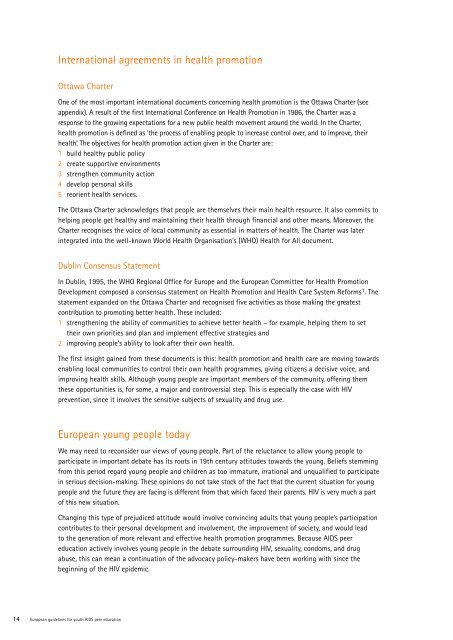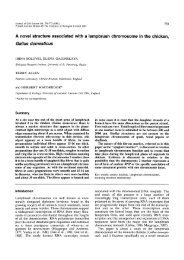European guidelines for youth AIDS peer education - University of ...
European guidelines for youth AIDS peer education - University of ...
European guidelines for youth AIDS peer education - University of ...
- No tags were found...
You also want an ePaper? Increase the reach of your titles
YUMPU automatically turns print PDFs into web optimized ePapers that Google loves.
International agreements in health promotionOttawa CharterOne <strong>of</strong> the most important international documents concerning health promotion is the Ottawa Charter (seeappendix). A result <strong>of</strong> the first International Conference on Health Promotion in 1986, the Charter was aresponse to the growing expectations <strong>for</strong> a new public health movement around the world. In the Charter,health promotion is defined as ‘the process <strong>of</strong> enabling people to increase control over, and to improve, theirh e a l t h .’The objectives <strong>for</strong> health promotion action given in the Charter are:1 build healthy public policy2 create supportive environments3 strengthen community action4 develop personal skills5 reorient health services.The Ottawa C h a r t e racknowledges that people are themselves their main health resource. It also commits tohelping people get healthy and maintaining their health through financial and other means. Moreover, theC h a r t e rrecognises the voice <strong>of</strong> local community as essential in matters <strong>of</strong> health. The C h a r t e rwas laterintegrated into the well-known World Health Organisation’s (WHO) Health <strong>for</strong> All document.Dublin Consensus StatementIn Dublin, 1995, the WHO Regional Office <strong>for</strong> Europe and the <strong>European</strong> Committee <strong>for</strong> Health PromotionDevelopment composed a consensus statement on Health Promotion and Health Care System Re<strong>for</strong>ms 1 . Thestatement expanded on the Ottawa Charter and recognised five activities as those making the greatestcontribution to promoting better health. These included:1 strengthening the ability <strong>of</strong> communities to achieve better health – <strong>for</strong> example, helping them to settheir own priorities and plan and implement effective strategies and2 improving people’s ability to look after their own health.The first insight gained from these documents is this: health promotion and health care are moving towardsenabling local communities to control their own health programmes, giving citizens a decisive voice, andimproving health skills. Although young people are important members <strong>of</strong> the community, <strong>of</strong>fering themthese opportunities is, <strong>for</strong> some, a major and controversial step. This is especially the case with HIVprevention, since it involves the sensitive subjects <strong>of</strong> sexuality and drug use.<strong>European</strong> young people todayWe may need to reconsider our views <strong>of</strong> young people. Part <strong>of</strong> the reluctance to allow young people toparticipate in important debate has its roots in 19th century attitudes towards the young. Beliefs stemmingfrom this period regard young people and children as too immature, irrational and unqualified to participatein serious decision-making. These opinions do not take stock <strong>of</strong> the fact that the current situation <strong>for</strong> youngpeople and the future they are facing is different from that which faced their parents. HIV is very much a part<strong>of</strong> this new situation.Changing this type <strong>of</strong> prejudiced attitude would involve convincing adults that young people’s participationcontributes to their personal development and involvement, the improvement <strong>of</strong> society, and would leadto the generation <strong>of</strong> more relevant and effective health promotion programmes. Because <strong>AIDS</strong> <strong>peer</strong><strong>education</strong> actively involves young people in the debate surrounding HIV, sexuality, condoms, and drugabuse, this can mean a continuation <strong>of</strong> the advocacy policy-makers have been working with since thebeginning <strong>of</strong> the HIV epidemic.14 <strong>European</strong> <strong>guidelines</strong> <strong>for</strong> <strong>youth</strong> <strong>AIDS</strong> <strong>peer</strong> <strong>education</strong>
















